The average hourly earnings of hired US farm workers are rising faster than the average earnings of US nonfarm production workers. The earnings of all US hired farm workers averaged $15 an hour in 2019, according to USDA’s Agricultural Labor Survey, while nonfarm US workers in the BLS Current Employment Statistics program earned an average of $24 an hour.
There are several reasons why farm earnings are rising faster than nonfarm earnings. First is the slowdown in unauthorized Mexico-US migration. Unauthorized workers pay their own way to the US and arrange for their own housing and rides to work. In 2000, almost a quarter of crop workers were unauthorized newcomers who were in the US less than a year. Today, the share of unauthorized newcomers is almost zero.
Pew estimates that the number of unauthorized foreigners in the US fell 14 percent, from 12.2 million in 2007 to 10.7 million in 2017.
Second is rising state minimum wages: 29 states had minimum wages higher than the federal $7.25 an hour minimum wage in 2020, including six states that had minimum wages of $12 or more. Farm workers are generally covered by state minimum wage laws, so rising state minimum wages help to increase farm worker hourly earnings.
Third is rising demand for hired workers in US agriculture. The average number of farm workers reported by employers to unemployment insurance authorities in each state, an estimated 85 percent of all US farm workers, rose from 1.1 million to 1.3 million across the US between 2009 and 2018, and from 374,000 to 423,000 in California. Smaller employers and H-2A workers are excluded from these data in some states.
Most data suggest that farm workers are working more hours a year as new plant varieties extend seasons. In the 1980s and 1990s, many seasonal workers were employed about half of the standard 2,000 hour work year for half of the average nonfarm wage, so they earned a quarter as much as nonfarm workers. Today many hired workers are employed for 1,500 hours a year and earn two-thirds as much as nonfarm workers, so their annual earnings are half of the $45,000 a year of nonfarm workers.
Farm work was once synonymous with poverty. Today, the poverty rate for farm worker families is 20 percent, twice the 10 percent rate for all US families. However, 80 percent of farm worker families have incomes above the poverty line.
Rising farm worker earnings and more hours of work each year encourage the settlement of farm workers near their farm jobs. Over 80 percent of farm workers live off the farm where they work, and most carpool to their farm jobs. Fewer than 10 percent of hired farm workers are follow-the-crop migrants, meaning that they move with the ripening crops and have multiple farm employers. However, more farm workers are being brought to farms by labor contractors, so that some workers are employed by one contractor on multiple farms.
If current trends continue, farm worker earnings are likely to continue rising faster than nonfarm earnings. There is little prospect of a new influx of unauthorized workers, and many states index their minimum wages to inflation or raise their minimum wages in other ways so that they will soon be $15 an hour. Average hours worked could fall if state laws that require farmers to pay overtime wages after eight hours a day or 40 hours a week lead to shorter work days, while hourly and annual earnings could rise if more of the hours that are worked are overtime hours that garner premium pay.
A major labor cost uncertainty is the H-2A program, which provides visas to mostly Mexican guest workers who fill about 10 percent of the full-time equivalent jobs on crop farms. Most guest workers are in the US 25 weeks a year, and many work 50+ hours a week or 1,250 hours while in the US.
If the average duration of US work for H-2A workers remains at six months, how will farm employers manage long work weeks in states that require overtime pay? Growers may use overtime hours and pay as a reward for their best workers. Alternatively, they could hire more H-2A workers and limit work weeks to 40 hours to avoid overtime pay.
The average hourly earnings of all hired farm workers have been 60 percent or more of nonfarm production worker earnings since 2016
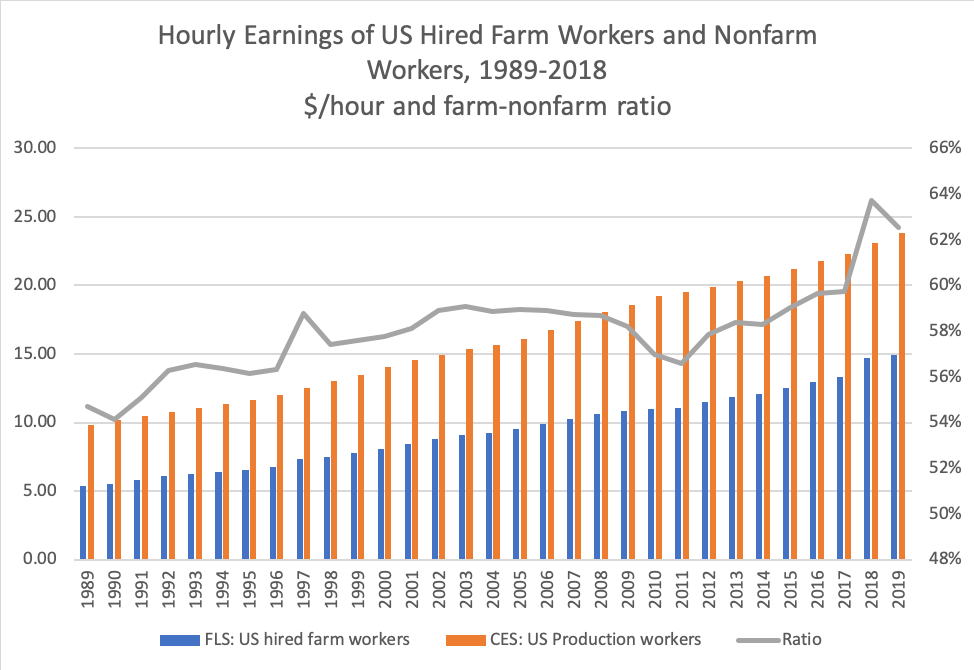
The number of unauthorized foreigners in the US fell 14% between 2007 and 2017
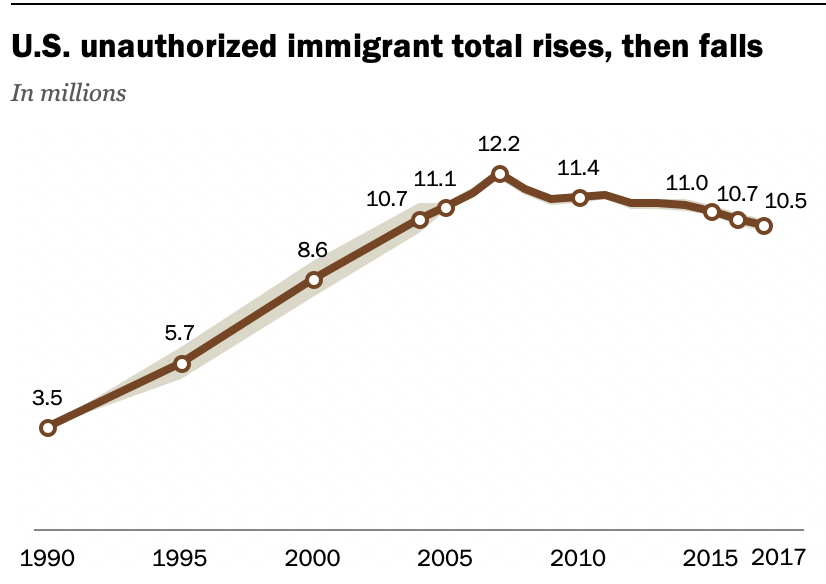
29 states have minimum wages higher than the federal $7.25 an hour in 2020, including 6 with minimum wages above $12
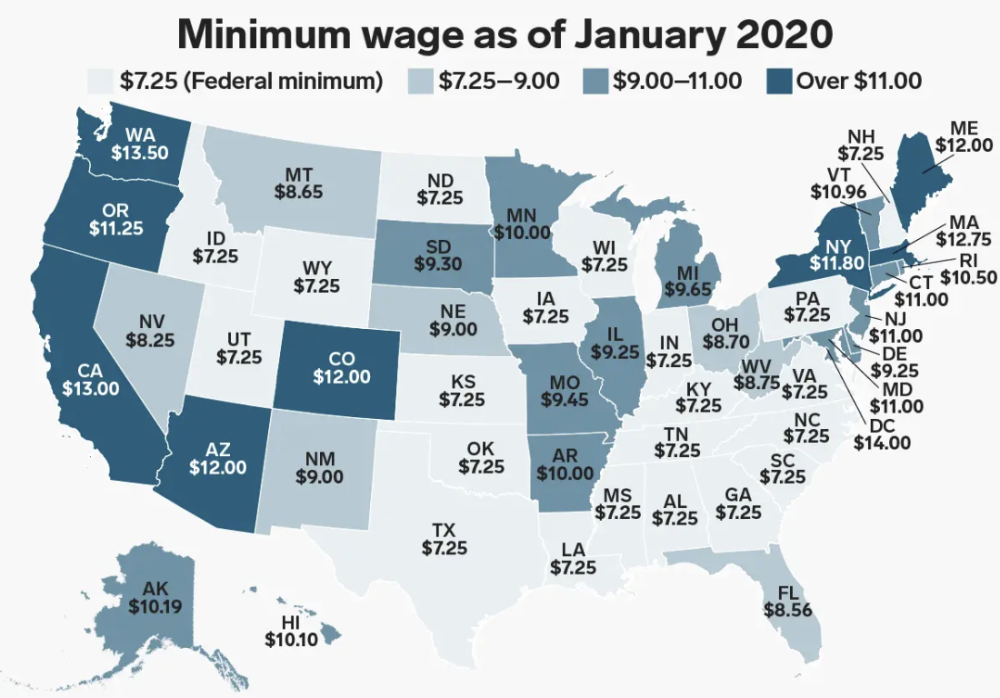
The demand for hired workers is rising, increasing average employment in NAICS 11
NAICS 11 US CA CA Share
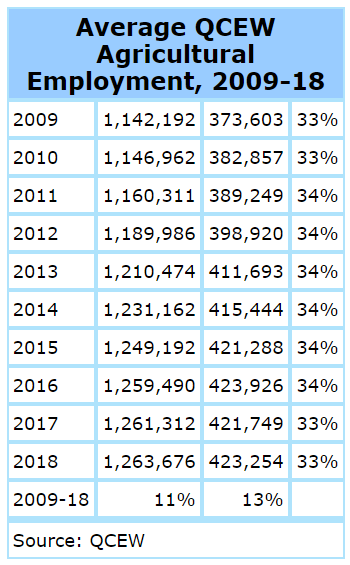
The number of H-2A jobs certified and visas issued doubled between FY12 and FY19
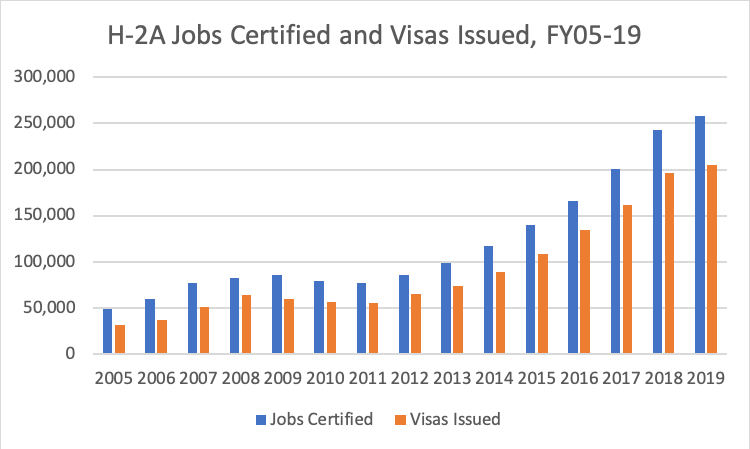
Author


Mexico Institute
The Mexico Institute seeks to improve understanding, communication, and cooperation between Mexico and the United States by promoting original research, encouraging public discussion, and proposing policy options for enhancing the bilateral relationship. A binational Advisory Board, chaired by Luis Téllez and Earl Anthony Wayne, oversees the work of the Mexico Institute. Read more




